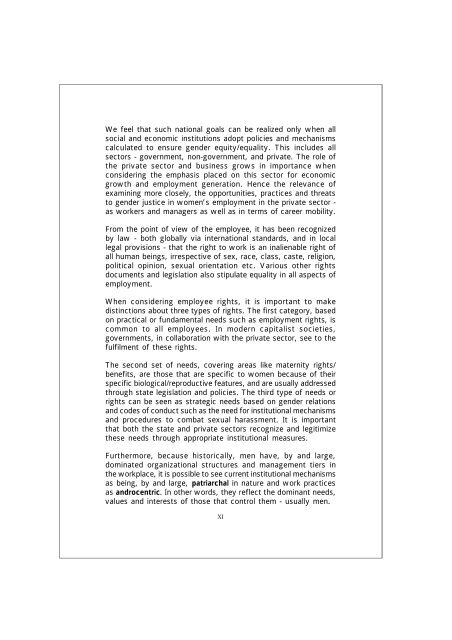Beyond Glass Ceilings and Brick Walls - International Labour ...
Beyond Glass Ceilings and Brick Walls - International Labour ...
Beyond Glass Ceilings and Brick Walls - International Labour ...
Create successful ePaper yourself
Turn your PDF publications into a flip-book with our unique Google optimized e-Paper software.
We feel that such national goals can be realized only when all<br />
social <strong>and</strong> economic institutions adopt policies <strong>and</strong> mechanisms<br />
calculated to ensure gender equity/equality. This includes all<br />
sectors - government, non-government, <strong>and</strong> private. The role of<br />
the private sector <strong>and</strong> business grows in importance when<br />
considering the emphasis placed on this sector for economic<br />
growth <strong>and</strong> employment generation. Hence the relevance of<br />
examining more closely, the opportunities, practices <strong>and</strong> threats<br />
to gender justice in women’s employment in the private sector -<br />
as workers <strong>and</strong> managers as well as in terms of career mobility.<br />
From the point of view of the employee, it has been recognized<br />
by law - both globally via international st<strong>and</strong>ards, <strong>and</strong> in local<br />
legal provisions - that the right to work is an inalienable right of<br />
all human beings, irrespective of sex, race, class, caste, religion,<br />
political opinion, sexual orientation etc. Various other rights<br />
documents <strong>and</strong> legislation also stipulate equality in all aspects of<br />
employment.<br />
When considering employee rights, it is important to make<br />
distinctions about three types of rights. The first category, based<br />
on practical or fundamental needs such as employment rights, is<br />
common to all employees. In modern capitalist societies,<br />
governments, in collaboration with the private sector, see to the<br />
fulfilment of these rights.<br />
The second set of needs, covering areas like maternity rights/<br />
benefits, are those that are specific to women because of their<br />
specific biological/reproductive features, <strong>and</strong> are usually addressed<br />
through state legislation <strong>and</strong> policies. The third type of needs or<br />
rights can be seen as strategic needs based on gender relations<br />
<strong>and</strong> codes of conduct such as the need for institutional mechanisms<br />
<strong>and</strong> procedures to combat sexual harassment. It is important<br />
that both the state <strong>and</strong> private sectors recognize <strong>and</strong> legitimize<br />
these needs through appropriate institutional measures.<br />
Furthermore, because historically, men have, by <strong>and</strong> large,<br />
dominated organizational structures <strong>and</strong> management tiers in<br />
the workplace, it is possible to see current institutional mechanisms<br />
as being, by <strong>and</strong> large, patriarchal in nature <strong>and</strong> work practices<br />
as <strong>and</strong>rocentric. In other words, they reflect the dominant needs,<br />
values <strong>and</strong> interests of those that control them - usually men.<br />
XI
















